
WHEN NATURE AND ART EMBRACE TO MAKE A HAPPIER WORLD
April 4, 2025 - Elaine King
At a time when the world is literally in a mess, when we humans are bombarded at every turn with war and sadness, there has never been a better time for an art exhibition that offers an escape into the magic and healing powers of Mother Nature.
Poetry of The Earth is a grand exhibition that opened on March 22 at Knysna Fine Art. Select and important South African artists, who work in different genres and mediums, were given a theme and each one of their art pieces is a unique interpretation of it.
Among the 50 participating artists from all over South Africa are important names like Phillemon Hlungwani, Norman O’Flynn, Jaco Benade, Jaco Schalkwyk, Nhlanhla Nhlapho, Andrew Mogridge, Arabella Caccia and Cobus Haupt. There is painting, sculpture, ceramic, drawing, etching and mixed media – a glorious trove of art – on show at this exhibition.
Get lost in the lush and captivating botanical paintings of Grabouw-based artist Lee-Ann Heath. Wander the gallery filled with eclectic work, both inspiring and challenging.
Curator of Knysna Fine Art Corlie de Kock gave participating artists a brief to capture a yearning that people have towards nature and spirituality in a troubled world.
“Nature is both beautiful, sublime, and dangerous. Plants can heal us, but they can also be poisonous. Animals are our companions, but some are completely reliant on our care while others can overpower us. Natural resources and land are threatened by human mismanagement and greed, yet we hold the ability to live in unison and prosper,” said De Kock.
Fine artist Angela Banks has The Silent Pact on display for this exhibition and in this exquisite and detailed oil painting, a girl is sitting on a vintage suitcase surrounded by wild cats in her space. It’s so real, I expect the girl to say something, for the cats to purr perhaps. No wonder there is a waiting list for her work.
Banks explains this painting fits perfectly into the theme Poetry of the Earth because her work revolves around the relationship between animals, humans and the land. “Here we see animals that could be dangerous to the girl, but they share a feeling of trust and even protection towards her, rather than fear.”
In her work, Banks aims to capture in permanent paint, a beautiful yet impermanent moment in time. Her meticulous attention to detail and form produces whimsical narratives of identity through the idiosyncratic relationships between human and animal.
Banks is a working-mom who fits painting in while her daughter is at school in the mornings. The Silent Pact was started in 2024 and a work of this magnitude takes about eight weeks.
Banks lives in Johannesburg. She has a BA (Fine Arts) and MA (Fine Arts) from the University of Pretoria. She has taken part in numerous exhibitions throughout South Africa and abroad, with five major solo exhibitions. She has been on residencies in both France and China.
“Living and working during an uncertain time in South Africa, I am happy to escape it all by delving into painting on a daily basis. Creating my own narratives and realities in the paintings is a way of escaping the real world for a while, and instead focusing on that which is appealing and uplifting,” says Banks.
“As an artist, I am largely influenced by what I consider to be beautiful and want to inspire people to look more carefully at the world around them, to discover charm in unusual places. By exploring the delicate relationship between man, animal and nature, I hope to create an alternative reality where things work very differently and life becomes a kind of dream. I wish for the viewer to be lost in imagination when standing in front of my painting… to slow down and be transported to another world.”
She more than achieves this.
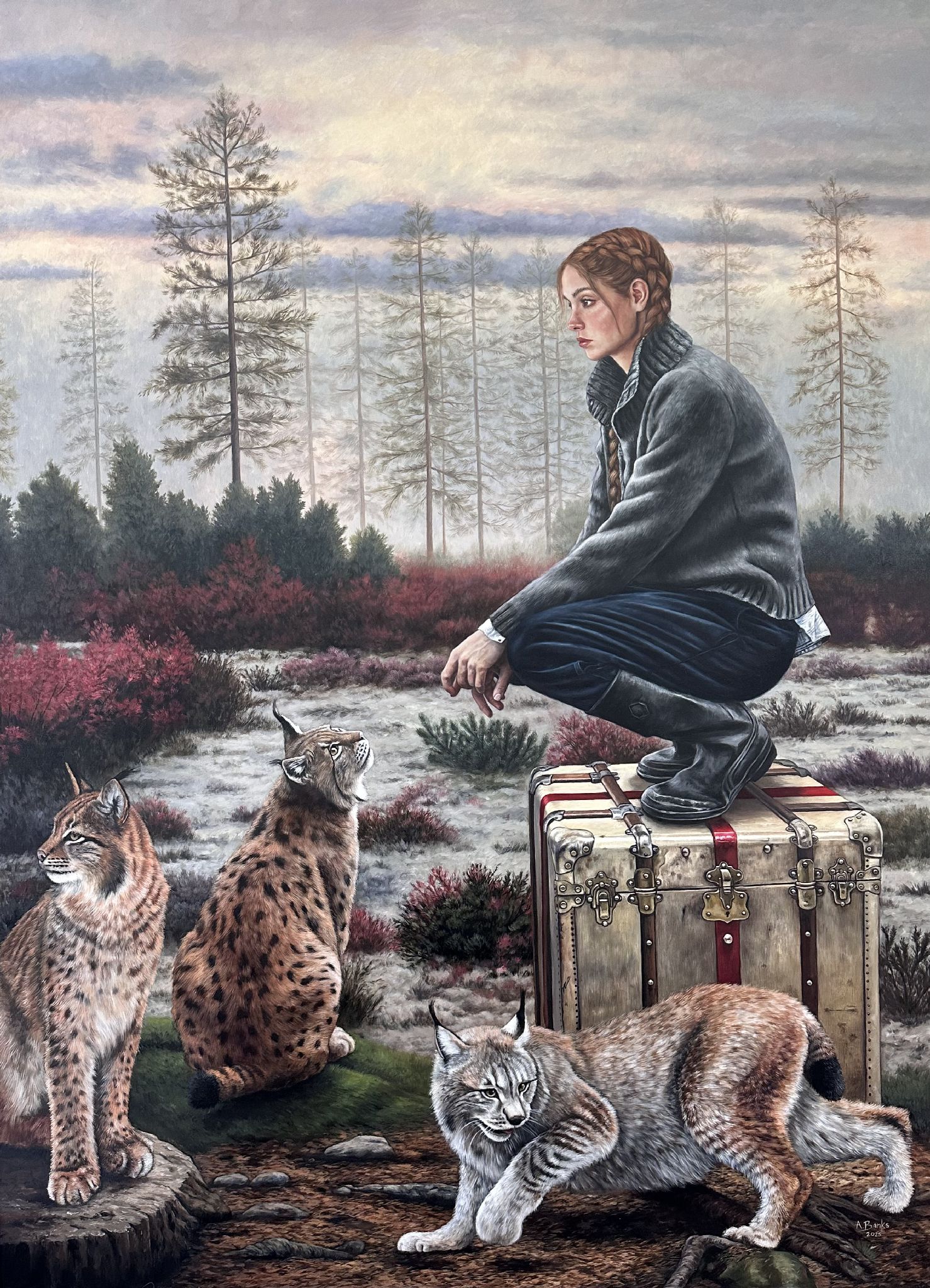
Image: The Silent Pact by Angela Banks, oil on canvas, 150 x 110 cm
Gary Stephens presents Graaff Reinet Aloe with Pod Pattern for this exhibition. It’s a charcoal and newsprint collage on Arches water colour paper. It’s big in size and big in presence at 133cm x 175cm. This and other works by Stephens take pride of place on prominent Knysna Fine Art gallery walls.
The American-born artist’s work is arresting, it’s fresh, complex and at the same time cheerful as he shares his self-confessed love for South Africa. Graaff Reinet Aloe with Pod Pattern portrays the beauty and the magic of the Karoo. “I first saw these aloes on a road trip to Graaf Reinet so I stayed a couple days, hiked the area and photographed it in various lights. I went back again to see the aloes in bloom before doing this piece,” says Stephens.
He says that it portrays the complexity of the area and by adding pods in the sky and other elements he has managed to make it magical, poetic and playful.
Stephens is drawn to patterns and visual rhythms, such as geometric repetitions, textile patterns, or botanical shapes and often creates layers of patterns that offset and energize the image in the foreground.
Born in the Mexican border town of Yuma, Arizona, Stephens studied painting and drawing at the University of Arizona and the San Francisco Art Institute. For the past 40 years, he has worked as an artist and travelled extensively in Latin America, Asia, Europe and Africa always in search of inspiration.
Since 2008, Stephens has been living and working in South Africa – where his work began on a series of monumental portraits of his artist friends and their African sense of style and dress.
He says that he has returned to landscape art in the last two years, but all his work engages with the beauty of the African continent. Stephens’ work is in public and private collections in the US, Europe and the Middle East, Nigeria and Ghana. He is an important globally-renown and exhibited artist.
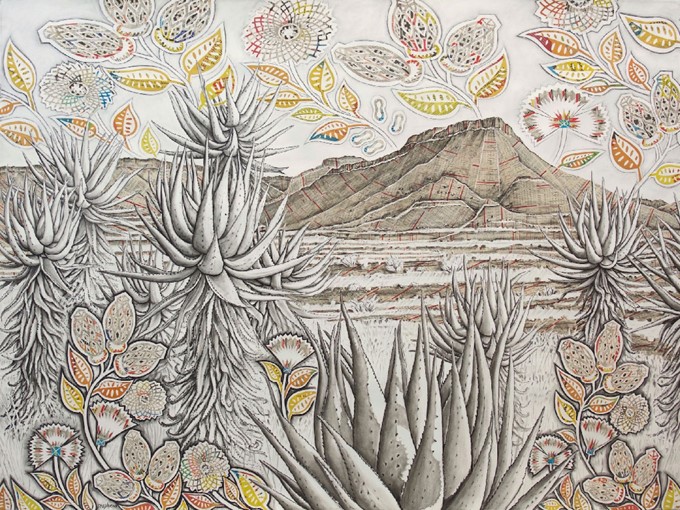
Image: Graaff Reinet Aloe with Pod Pattern by Gary Stephens, charcoal & newsprint collage on arches watercolour paper, 133 x 175 cm
Bronze sculptor Robert Leggat’s Idiom Cat 2/10, 2023 is an example of a sculpture that is anatomically perfect. I find myself wanting to stroke it ,as it balances as only a cat could do on books which depict its nine lives. This sculpture is sold, but Leggat is busy with the next edition of it.
The White Starred Robin is an intricate bronze statue of this little forest bird in amongst a branch and leaves. Its eyes are fashioned from onyx stones and the white stars on its body are made from mother of pearl.
“It’s a bird that lives deep in the forest and it flashes its spots when there is a predator or when it is flirting,” says Leggat, who aims to make his subjects as real as possible.
His life-size The Walking Albatross, now on exhibit at Knysna Fine Art, is in its ninth edition and there will only be 10 of them. The others have flown the nest, says Leggat. One lives on a windy cliff in Cornwall and Birdlife South Africa bought one to be given as a gift to British Royalty.
Leggat prides himself on great sensitivity and realistic depiction of textures and natural forms. He has been turning ideas into reality since 2006 and his attention to detail is exceptional. He spends long hours observing, drawing and sketching his subjects preferably in their natural environment, but for some of his pieces he goes to great lengths to borrow taxidermic examples from collection and museums.
In 2006 Leggat started Bronze Fields Art Studio and Foundry, on a smallholding on the outskirts of Plettenberg Bay. He emphasises that he does not delegate any of the processes of his work, is involved from the start to the finish, from drawing, creating a maquette, building an armature (the internal framework that will support the sculpture) to casting the sculpture using the lost wax method (cire perdu) to finally the patination.
Leggat Studied Fine Art at the Cape Technicon (now called the Cape Peninsula University of Technology) majoring in sculpture and he completed his qualification at the Pretoria Technicon in 1988.
He is passionate about the environment and protecting the places and creatures which he makes. Leggat’s pieces are sought after by collectors world-wide while he also receives many commissions, privately and in the corporate sector.
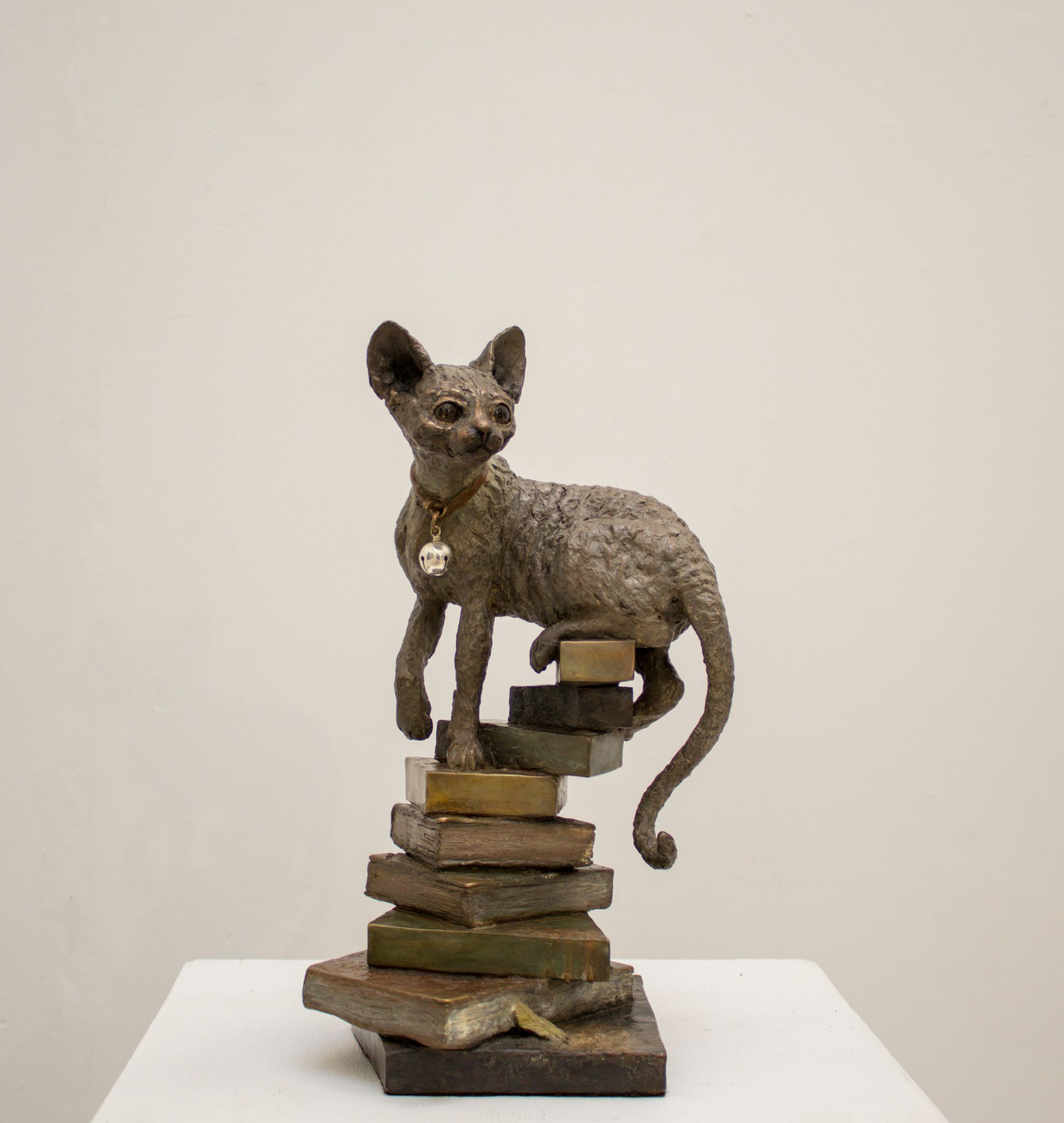
Image: Idiom Cat by Robert Leggat, bronze edition of 10, 40 x 19 x 18 cm
Brendan Leggat is showing a bronze edition called Great White Pelican at this exhibition.
Great White Pelican is a life-size pelican and a welcome exhibit as it rests on the floor of Knysna Fine Art with large webbed feet and a dramatic bill, so real it could waddle away.
Leggat says he first saw pelicans flying over a vlei outside Cape Town and thought what a beautiful bird. “It’s also super-quirky and interesting, especially the way it walks,” says Leggat proud to have his life-size pelican playing its part in Poetry of The Earth.
Following in his father Robert’s footsteps, Brendan Leggat emerged as a talented sculptor at a young age and had his first exhibition at the age of 16. Now at the age of 29, Leggat has had 13 exhibitions in South Africa and worked on many commissions.
With a distinctive style that is free and boldly textured, his sculptures have a touch of whimsy and humour that draw a smile.
He is not afraid of creating an unconventional pairing such as a bushbuck with a Vervet monkey on its back – reminiscent of Aesop’s Fables. Some of his popular pieces include a pig with a Sacred Ibis perched on its back, a pair of donkey heads in harness, scoffing pigs, Karoo sheep and a family of Buff Orpington chickens.
Brendan’s work is highly captivating and sought after and there’s a great future for this young artist, say important curators.
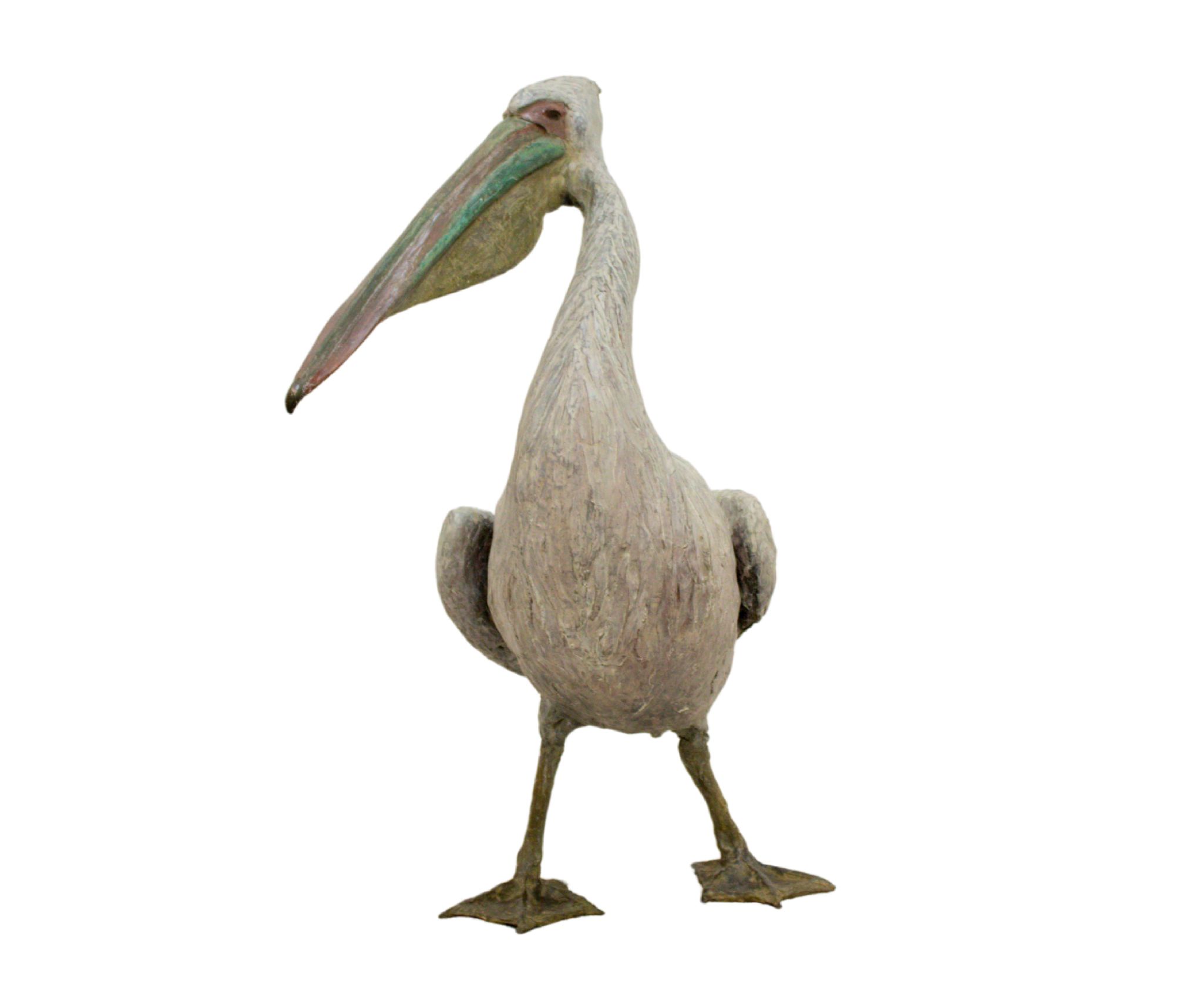
Image: Great White Pelican by Brendan Leggat, bronze edition 3/12, 92 x 78 x 52 cm
Jan Tshikhuthula’s Royal Garden is soft pastel on paper, it’s contemporary, it’s layered, it’s very beautiful as it depicts magical trees and clouds.
Tshikhuthula’s work is characterised by a sophisticated and elegant sense of design allied with an impeccable technique and superb drawing skills.
Tshikhuthula was born in Tzaneen, South Africa in 1983, and he received his original fine art education in Venda. In 2005 he studied at the Matongoni Art Academy under the mentorship of Avhashoni Mainganye, who encouraged him to specialise in printmaking at the Artist Proof Studio. He then moved to Johannesburg where he obtained his Professional Printmaking Certificate from the Artist Proof Studio in 2010.
His grandfather Jan worked on industrial water systems, so his landscapes invariably feature windmills, along with unusually gritty water machinery and equipment, which contrast strikingly with the sweeping colours and moods of the Venda region.
Tshikhuthula has participated in a number of group-shows with various Artist Proof Studio artists and continues to run a range of printmaking workshops with the Special Projects Outreach department at Artist Proof Studio.
"The landscape of my heart is changing," he says. "The longer I spend in the city, the more new metaphors and images come up. I'm still working on gathering history, using windmills and water pumps as a metaphor. Windmills are old things, but they pump up a lot of value. I am still on this idea, but it's growing. Life is moving into new forms and shapes. So am I," says Tshikhuthula.
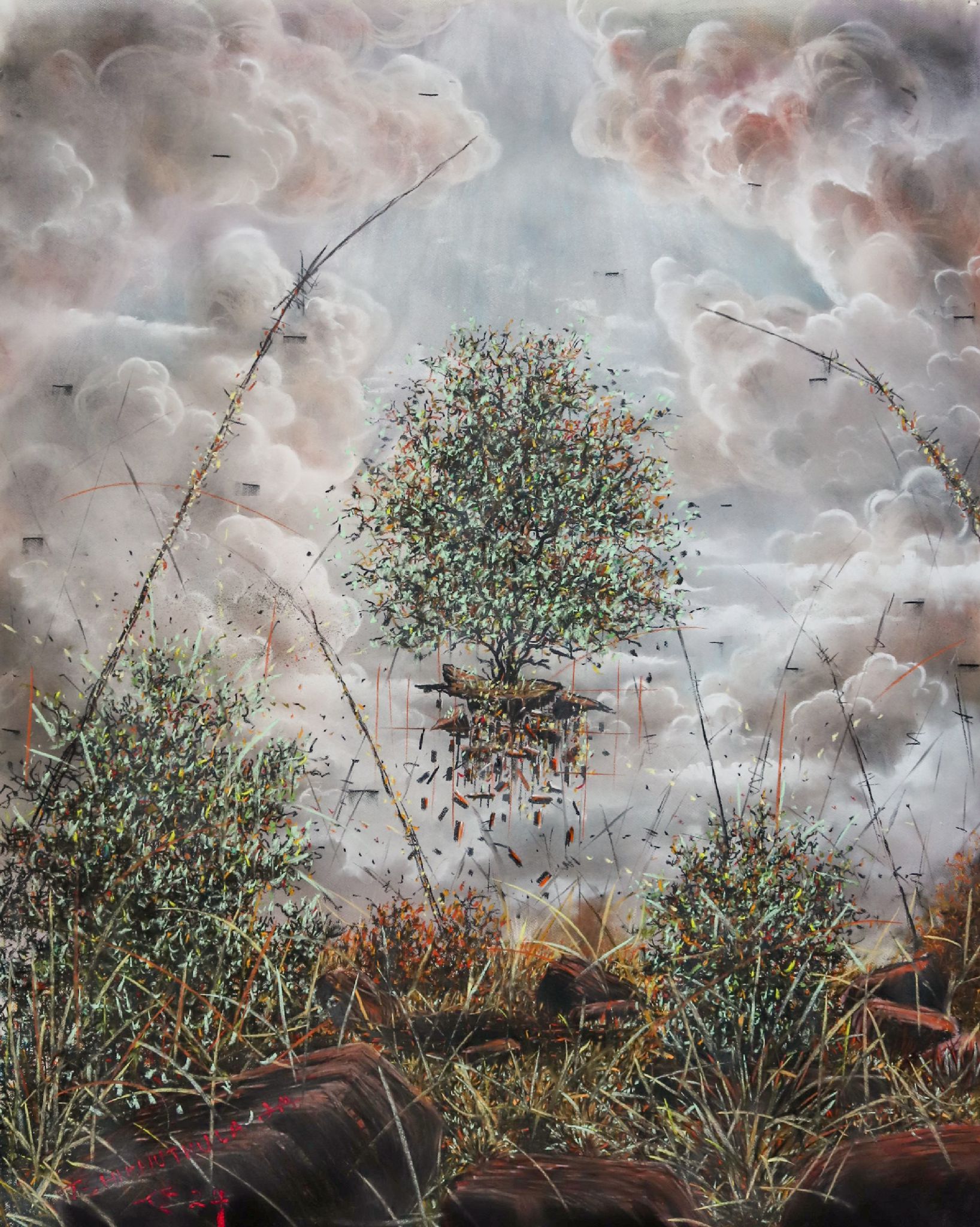
Image: Royal Garden by Jan Tshikhuthula, soft pastel on paper, 150 x 120 cm
Liza Grobler has Diepkyk, 2022 a big piece (165cmx165cm) of glass seed beads on a board for this exhibit. What is staggering about it is that it is made of millions of tiny beads, 25kg worth, which form a landscape and stage for the mind to wander wherever it goes.
Diepkyk is particularly dear to her for various reasons. “After Covid, I moved to Oudtshoorn and was touched and amazed by the vastness of the Klein Karoo. One might imagine it is a landscape of olive and brown, but far from it. It is a vast richness of colour and vegetation, of magic that I wanted to express,” says Grobler.
This bead panel took about 10 weeks to make, with the help of four expert-beading ladies, says Grobler. It was a collaboration with QaQambile Bead Studio in Cape Town who change brushstrokes into thousands of beads.
Born in 1974 Liza Grobler is an artist currently based in the Klein Karoo. She is a compulsive maker of things. Her work exists in physical space, but the worlds she creates are manifestations of imagined landscapes. The viewer is an accomplice who can step through the portals and move unhindered between fact and fabrication.
Grobler works with a variety of media often exploring ideas that bring together physical and psychological spaces and historical and ecological-scapes. Her practice is built around process, putting materiality and ephemerality of the objects and media she works with in tension.
At Context Art Miami (2019), director Julian Navarro mentioned her as one of five artists to watch. In 2016, she was a recipient of the Africa Centre Award and IZIKO Museums commissioned a site-specific work for the National Gallery. Grobler has been nominated for prestigious art prizes and has done residencies in Norway, Finland, Switzerland, Serbia, Belgium, France, Mexico, India and the United States.
Grobler’s exhibitions include solos in South Africa and Belgium and international group and numerous site-specific projects. She is represented by Everard Read Galleries (Cape Town, Johannesburg, London) and Uitstalling Gallery (Belgium).
A highlight Grobler says, is that she is now the curator for Visual Arts for Klein Karoo Nasionale Kunstefees (KKNK) for the next three years.
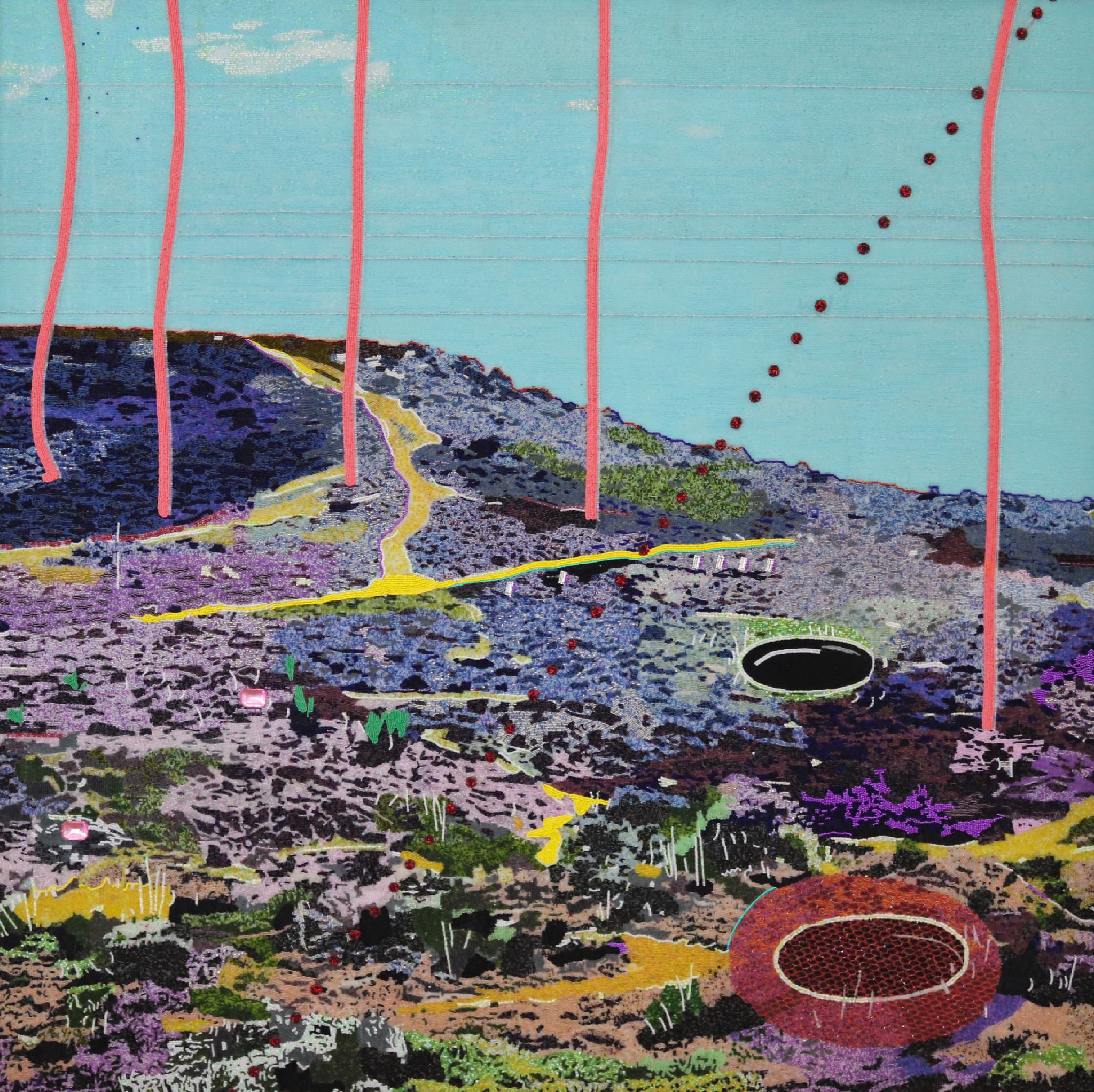
Image: Diepkyk by Liza Grobler, glass seed beads on board, 165 x 165 cm
Corlie de Kock curator of Knysna Fine Art is an accomplished artist in her own right and her Plant vir my ‘n boom is a bronze edition that fits the Poetry of Nature theme perfectly.
This 71cm x 40cm x 25 cm tree looks realistic and yet whimsical. It could be an ancient bonsai, it makes me think of the biblical Garden Of Eden trees, one a tree of life and the other the tree of knowledge of good and evil. De Kock says it’s sensual and the roots are an important component suggesting that trees communicate with one another. She mainly paints and this is one of her few bronze sculptures.
In 2003, De Kock did her Masters in Visual Arts at the Stellenbosch University having achieved a BA Visual Arts with a parallel major in philosophy. Her research and practical work has focused on the visual depiction of the South African landscape, political and ideological.
In 2002-2003 she was an exchange student at Aufbaustudium, Hochschule der Bildenden Künste, Hamburg, Germany.
In 2017 she was one of the top five Sanlam Portrait Award winners and in 2012 her work was recognised with a Vuleka Merit Award.
De Kock’s work has been shown in many important South African exhibitions and also in 2023 at the Featherstone Center for the Arts gallery, Marthas Vinyard, USA. She has curated many important exhibitions in South Africa and lectured art. She says her work travels to places and countries she may never visit, like Texas, but she likes to think it brings joy wherever it lands up.
This exhibition is very important to De Kock not only as a curator, but also as an artist, as it comes at a time when it feels like the world is in a dark place. Art is a form of escapism and something that brings healing and joy, she explains.
Image below: Plant vir my ‘n boom by Corlie de Kock, bronze edition of 10, 71 x 40 x 25 cm
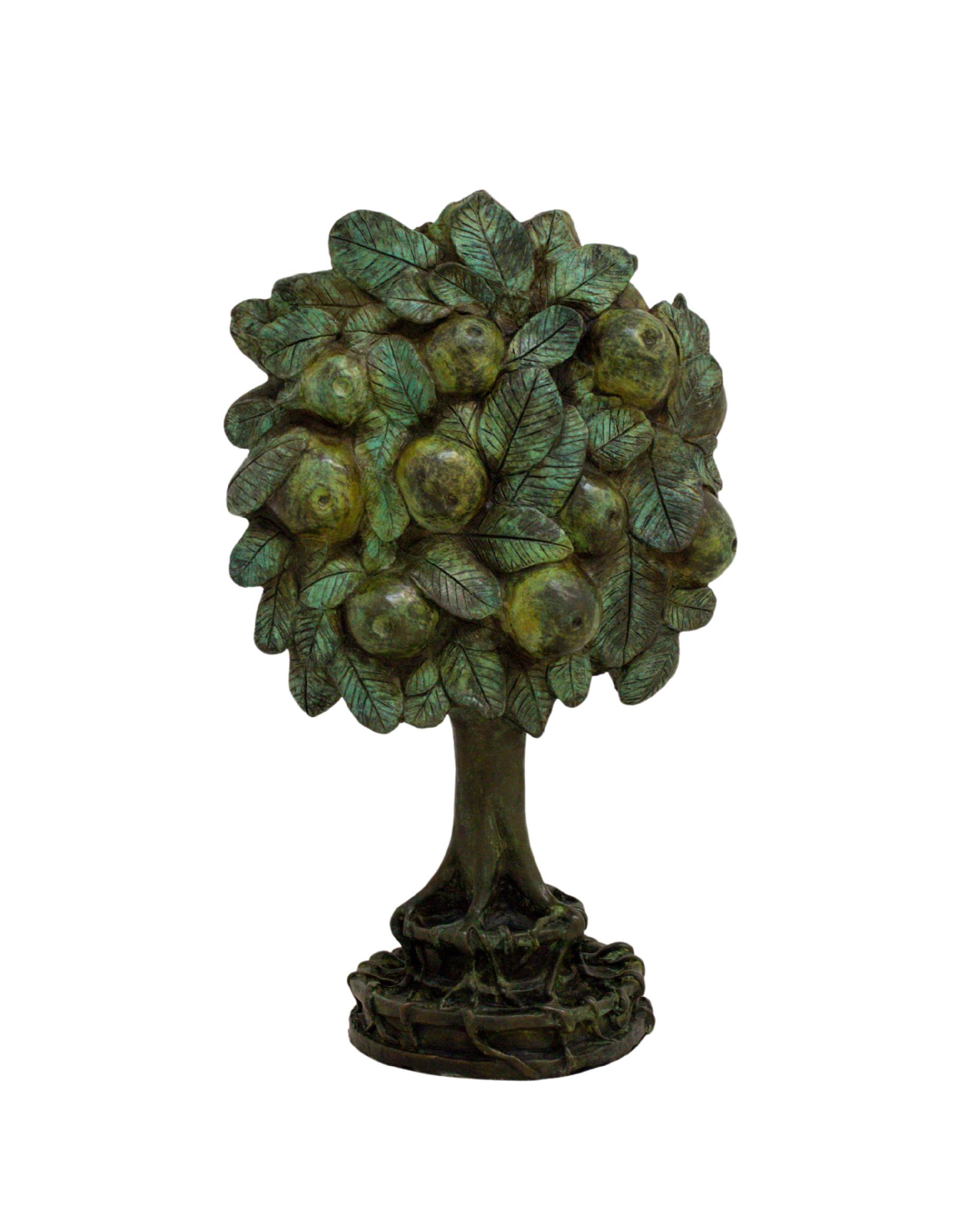
Back to News
